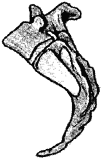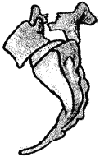Source: http://www.parenting-weblog.com/Think of late pregnancy. What do you think of? - That healthy pregnant glow? The smile and cheer associated with the idea that a new life is about to be brought into this world? Baby showers?
No, way! Most women (and the people who love them) who have been at the end of a long pregnancy think of other things: swollen feet, difficulty arising from a chair, difficulty catching a breath because baby is huge and pushing Mommy’s lungs into her throat, heart burn, and back pain.
Pregnancy is an incredible gift - it would be even better if gestation only lasted seven months, instead of nine. By the time Mom is nine months pregnant, the baby and Mom’s body have reached sizes that put tremendous strains and demands on all of Mom’s systems.

Osteopathic manipulative treatment (OMT) can provide temporary relief for some of these problems. There are even treatments which I have taught prospective fathers to do on their partners at home, when the pain returns. Unfortunately, the return of pain is virtually inevitable until the source of the bodily stress (i.e. bun in the oven) is gone.
Source:
http://www.spineuniverse.com/Two of the most common types of low back pain seen in pregnant women in my practice are lumbosacral (i.e. low back) pain and Pyriformis muscle (i.e. buttock region) pain. I’ll talk about lumbosacral pain, today and pyriformis pain, tomorrow.
Lumbosacral pain, occurring where the lumbar spine sits on the sacrum (tailbone), happens because baby sticks out so far in front of Mom’s spine that it pulls on the spine causing the forward curve of the spine to increase dramatically. The fifth lumbar vertebra can actually be slid forward by this pulling. Ouch.

Source: Colorado Spine Institute
Fortunately, there is a neat remedy called the Frog-Leg Technique which an osteopath can perform on Mommy. Without going into detail, Mommy lies on her back while the D.O. slides his hand under her tailbone. While the doctor gently pulls the tailbone down toward Mom’s feet, he asks Mom to do a few things, such as taking a deep breath and holding it. All of this pulls the sacrum out of the way and allows the fifth lumbar vertebra to slide back into place. The nice thing about this technique is it not only reduces or eliminates pain but, when the pain returns, Dad (who has been taught how by the Doctor) can fix the problem for Mom anytime she needs it.

